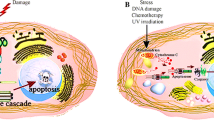Summary
Early chromatin condensation in interphase cells (G1) of human peripheral blood lymphocytes has been induced without virus or cell fusion by exposure to allogeneic or xenogeneic mitotic cells. The event, although similar in some ways to the phenomenon described as “premature chromosome condensation”, “chromosome pulverization”, and “prophasing”, differs in that it does not require the presence of viruses and cell fusion before mitosis proceeds in the G1 cell.
Early chromatin condensation in interphase cells induced by mitotic cells only, consists of chromatids in the early or late G1 phase of the cell cycle that are not pulverized or fragmented at mitosis. Some of the chromosomes are twice as long as the metaphase chromosomes and exhibit natural bands. Almost twice as many of these bands are produced as by trypsin treatment of metaphase chromosomes. The nuclear membrane is intact and nucleoli are present, to which some chromosomes are attached. The DNA content of the precocious chromosomes in G1 is half the amount of the metaphase complement.
Similar content being viewed by others
References
Johnson, R. T., P. N. Rao, and H. D. Hughes. 1970. Mammalian cell fusion. III. A HeLa cell inducer of premature chromosome condensation active in cells from a variety of animal species. J. Cell. Physiol. 76: 151–158.
Rao, P. N., and R. T. Johnson. 1970. Mammalian cell fusion: studies on the regulation of DNA synthesis and mitosis. Nature 225: 159–164.
Johnson, R. T., and P. N. Rao. Mammalian cell fusion: induction of premature chromosome condensation in interphase nuclei. Nature 226: 717–722.
Rao, P. N., and R. T. Johnson. 1972. Premature chromosome condensation. A mechanism for the elimination of chromosomes in virus-fused cells. J. Cell Sci. 10: 495–513.
Nichols, W. W., A. Levan, P. Aurla, and E. Norrby. 1965. Chromosome damage associated with the measles virusin vitro. Hereditas 54: 101–118.
Kato, H., and A. A. Sandberg. 1967. Chromosome pulverization in human binucleate cells following colcemid treatment. J. Cell Biol. 34: 35–45.
Matsui, S., H. Weinfeld, and A. A. Sandberg. 1971. Dependence of chromosome pulverization in virus-fused cells on events in the G2 period. J. Natl. Cancer Inst. 47: 401–409.
Matsui, S., H. Yoshida, H. Weinfeld, and A. A. Sandberg. 1972. Induction of prophase in interphase nuclei by fusion with metaphase cells. J. Cell Biol. 54: 120–132.
Matsui, S. 1973. “Prophasing” as a possible cause of chromosome translocation in virus-fused cells. Nature New Biol. 243: 208–209.
Matsui, S., H. Weinfeld, and A. A. Sandberg. 1972. Fate of chromatins of interphase nuclei subjected to “prophasing” in virus-fused cells. J. Natl. Cancer Inst. 49: 1621–1632.
Stroud, A. N., R. Nathan, and K. S. Miller. 1973. Induction of premature chromosome condensation in interphase nuclei with metaphase cells (abstr.). Mammalian Chromosome Newsletter 14 (2): 81.
Stewart, C. C., and M. Ingram. 1967. A method for counting phytohemagglutinin-stimulated lymphocytes. Blood 29: 628–636.
Puck, T. T. 1965. Phasing mitotic delay and chromosomal aberrations in mammalian cells. Science 144: 565–566.
Mayall, B. H. 1969. Deoxyribonucleic acid cytophotometry of stained human leukocytes. I. Differences among cell types. J. Histochem. Cytochem. 17: 249–255.
Castleman, K. R., and R. J. Wall. 1973. Automatic systems for chromosome identification. In: T. Caspersson, L. Zech, and V. Runnstrom-Reio (Eds.),Nobel Symposium 23-Chromosome Identification. Academic Press, London, pp. 77–84.
Caspersson, T., K. R. Castleman, G. Tomakka, E. J. Modest, A. Moller, R. Nathan, R. J. Wa, and L. Zech. 1972. Automatic karyotyping of quinacrine mustard stained human chromosomes. Exp. Cell Res. 67: 233–235.
Wall, R. J. 1974. The gray level histogram for threshold boundary determination in image processing with applications to the scene segmentation problem in human chromosome analysis. (Ph.D. thesis, University of California, Los Angeles).
Hungerford, D. A., F. T. Ashton, B. B. Balaban, B. U. LaBadie, L. R. Messatizzia, G. Haller, and A. E. Miller. 1972. The C-group pachytene bivalent with a locus characteristic for parachromosomally situated particulate bodies (parameres): a provisional map in human males. Proc. Natl. Acad. Sci. U. S. A. 69: 2165–2168.
Author information
Authors and Affiliations
Additional information
This paper presents one phase of research carried out at the Jet Propulsion Laboratory, California Institute of Technology, under Research Contract NAS 7-100, sponsored by the National Aeronautics and Space Administration, and Biotechnology Resource Grant RR-00443 from the National Institutes of Health.
Rights and permissions
About this article
Cite this article
Stroud, A.N., Nathan, R. & Harami, S. Early chromosome condensation without cell fusion. In Vitro 11, 61–68 (1975). https://doi.org/10.1007/BF02624077
Issue Date:
DOI: https://doi.org/10.1007/BF02624077




